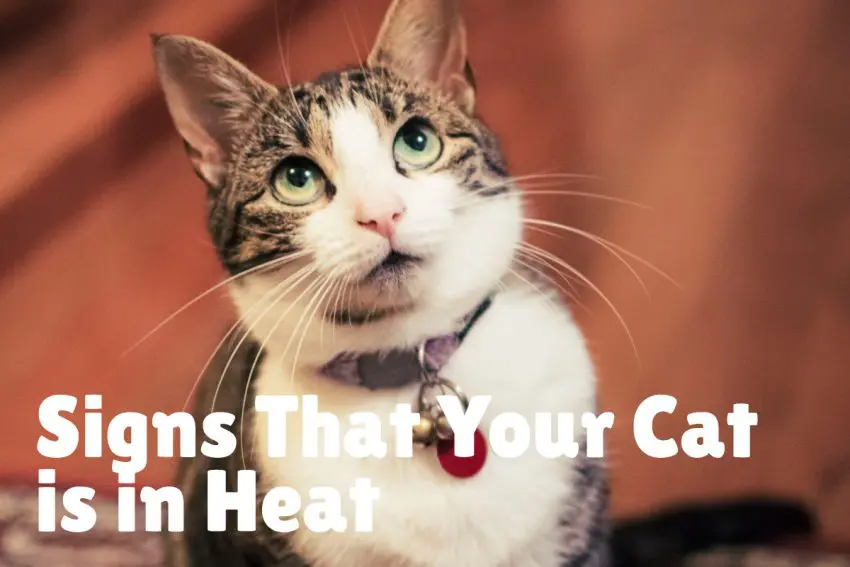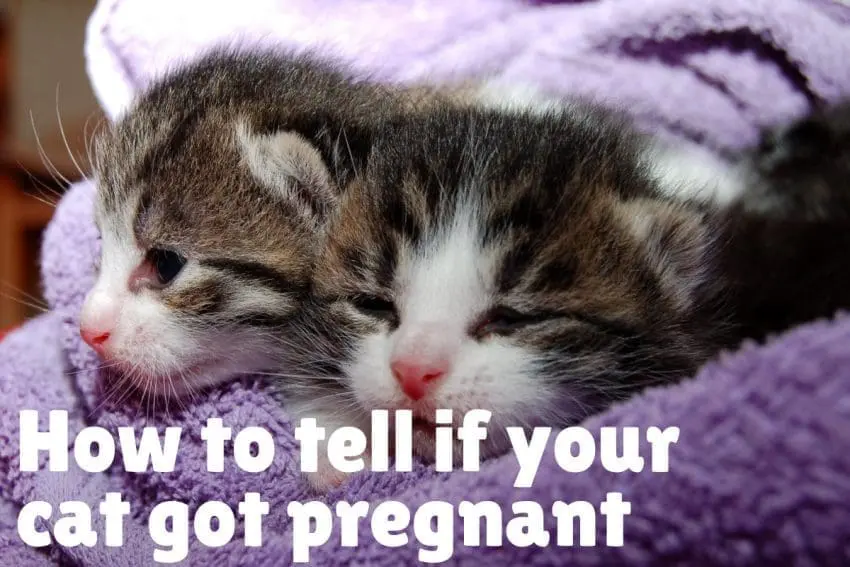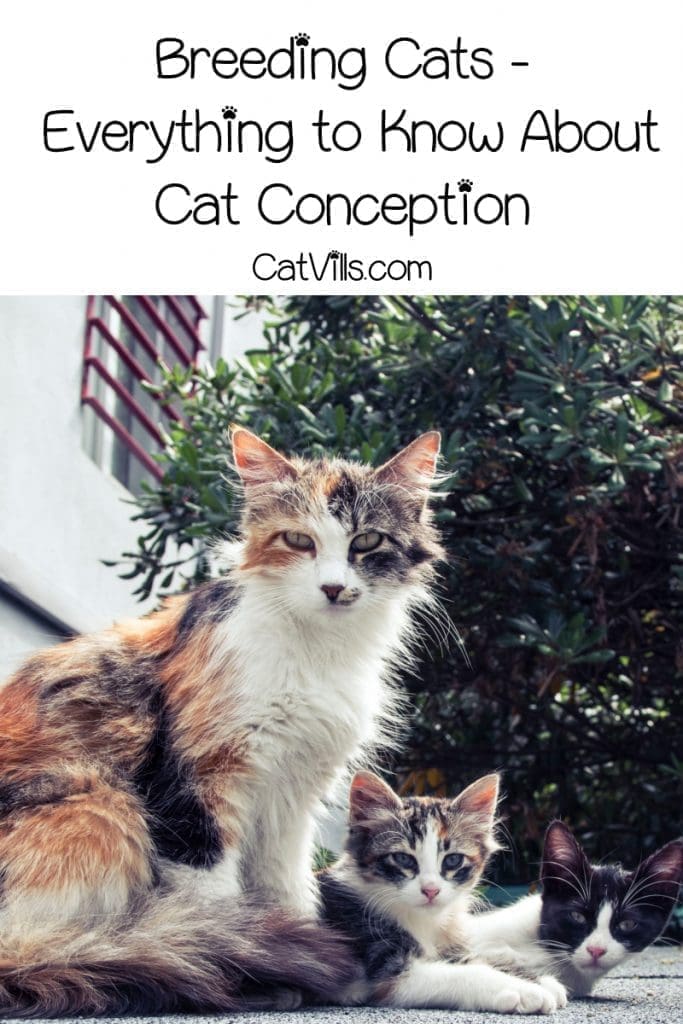Last Updated: 1 year ago
Breeding cats is a common topic of discussion among cat owners.
Some owners of pure-bred cats want to breed them in order to sell the kittens.
There are also owners of plain Jane “mutt” cats who just love the personalities of two cats and want to breed them.
In either case, there are things anyone who wants to breed cats needs to know about the initial process.
That’s why today we’re going to talk about what you need to know about breeding cats, from the biology of conception to how many kittens you can expect your cat to have.
The Biology of Breeding Cats
To the uninitiated, breeding cats may seem like an easy process.
After all, cats are notoriously promiscuous, rivaling the rabbit for their breeding practices.
Cats mate frequently and don’t really seem to care what cat they’re mating with so long as they’re mating.
In reality, there is much, much more involved with mating when it comes to our feline friends.
Signs of Being in Heat

Going into heat is the term used for the period of time in which a cat can conceive.
A cat’s heat cycle generally lasts around 14 days, with the time between heats being anywhere between one to six weeks.
A cat can go into heat as early as 4 1/2 to 5 months of age, so if you DO NOT want your cat to breed, talk with your vet about the appropriate time to have her fixed.
It’s recommended that you have her spayed before her first heat. This does two things.
- It ensures that there is no opportunity for her to become pregnant.
- Second, it drastically reduces her chances of developing breast cancer later in life.
However, if you want to breed your cat, it’s important to know the signs of being in heat. Don’t worry, they’re easy to spot.
One important thing to note is that cats CANNOT get pregnant if they are not in heat.
The idea that cats can get pregnant while not in heat most likely has roots in the fact that cats go into heat so often.
This myth has taken hold, and many people believe a cat can get pregnant at almost any time. However, this simply isn’t’ true.
1. Excessive Displays of Affection
Even if you have a very friendly cat, you’ll notice an out of the ordinary level of affection from your cat when she is approaching her heat.
It’s not uncommon for female cats to rub their hindquarters against furniture, stuffed toys, other cats, and even their owners during this time.
You can differentiate heat-induced affection from restlessness by the way the cat lifts her tail, as well as occasionally assuming the mating position.
2. Excessive Grooming
Female cats almost always begin to groom their genital area excessively during their heat cycles, even without the presence of blood.
In fact, it’s important to note that you should never see blood coming from your cat’s genital area during her heat cycle.
Cats don’t shed their uterine lining during their cycle the way humans do. Therefore, any blood in the area is cause for an immediate trip to the vet.
Likewise, excessive licking of the genitals can be a sign of a urinary tract infection, so if your cat shows no other signs of being in heat, take her to the vet for either of these two issues.
3. Excessive Vocalization
During your cat’s heat, she will vocalize often and loudly. This is called “calling”, and it may go on for several days unless she mates.
In the wild, this vocalization is an announcement of her readiness and willingness to mate to any male cats in the vicinity.
During and after her “calling”, she’ll assume the mating position, known as lordosis.
This is a clearly defined pose in which her head is down, her forelegs are bent, and her rear quarters are raised in the air to expose her genitals.
She will also have her tail raised and held to the side. While in this position, she will move her legs rhythmically, almost looking as if she’s walking in place.
4. Territorial Marking
Much like male cats marking their territory, female cats in heat will spray vertical surfaces in the home with a pungent fluid.
This scent is a biological homing beacon meant to alert any male cats in the area that she is in full heat and ready to mate.
To mark her spots, she will back up to the object with her tail raised and quivering.
She may even rhythmically move her hindquarters in much the same way as she would during lordosis.
To someone new to breeding cats, this may look like an act of pain or discomfort, but in reality, she is just ensuring that any male cat can catch her mating scent.
5. Inappetence
Loss of appetite is a common sign of a cat being in heat, as well. This is not due to nausea, however, as it is when she is pregnant.
Rather, her biological imperative shifts from her normal daily routines to finding a mate as quickly as possible.
She simply isn’t thinking about eating.
This should only last about two weeks. If it lasts any longer than that, see your vet immediately, even if you know for sure that your cat is in heat.
6. Attempts to Escape
The final sign of a cat in heat is a need to escape.
Owners who are breeding cats for the first time should pay extra attention to this one if they have an indoor kitty.
During her heat cycle, a female cat’s instincts shift towards mating above anything else.
In the absence of a male cat in the home, the only other option for mating is outside.
During her heat, she will constantly try to zip out of open doors and into the “wild” where she can find a potential mate.
It’s not uncommon for females in heat to disappear for a week or more while they search for a potential suitor.
If your cat is indoor only, it’s imperative that you keep a close watch when opening doors to prevent her great escape.
How Cats Get Pregnant

Unlike humans, cats don’t ovulate until they mate.
When a female goes into heat she is “primed” for mating, however, she does not have eggs ready and waiting for sperm.
Rather, the act of mating stimulates ovulation and the descent of her eggs into the uterus for fertilization.
In addition, female cats stay in heat even after they have mated, so they can, and frequently do, have litters of kittens that look quite different.
In fact, many female cats have kittens that are obviously from two to even four different males.
Mating Process
If breeding cats is on your agenda, it’s important to know that the act of mating between cats can sound awful and look even worse.
Many people who have witnessed cats mate have described the process as “barbaric” and “rape-like.”
It’s not. It’s just the way Mother Nature designed them.
When cats mate, they are very vocal, and the male will often bite the female around her neck and shoulders.
This is thought to stimulate the female’s brain to induce ovulation.
Inducing ovulation is key because female cats don’t actually ovulate until AFTER they have mated. If she doesn’t ovulate, all that effort is for nothing.
In addition to the biting and vocalizing, the female will most likely scream up completion of the mating process.
This is because male cats have barbed penises, and the withdrawal process can be painful for the female.
Again, this is just how Mother Nature designed these creatures. The barb is thought to stimulate ovulation just like the neck biting. If this all sounds terrible to you, don’t worry.
The entire mating process only lasts for a few minutes, and although the female may scream at the end, she is still quite affectionate and playful with her male counterpart after it’s all over. She experiences no trauma.
How Many Kittens Can a Cat Have?

One of the key things to think about if you’re breeding cats is litter size. Unfortunately, cat litter sizes vary dramatically from 1 to over 10.
In general, however, cat litters average around 3 to 5 kittens.
Your vet will want to x-ray your cat at some point. That will tell you exactly how many kittens your cat is having.
How to Tell if the Breeding Cats Bred

Unfortunately, there is no way to tell from the start if the mating process was successful.
You’ll just have to wait until your cat begins to show signs like weight gain and swelling of the nipples.
You can consult my in-depth guide to cat pregnancy for a complete rundown of what to look for when a cat is pregnant.
Final Word
If breeding cats is on your radar, bookmark this page and refer to it often.
It has all the pertinent information you need to know about breeding cats and the processes involved.
Of course, this is only a reference sheet – a companion piece, if you will.
Be sure that you are in contact with your vet every step of the way through this process to ensure a safe, healthy cat breeding experience for your cat.
Do you have any questions on breeding cats? Any tips to include? Share below!

